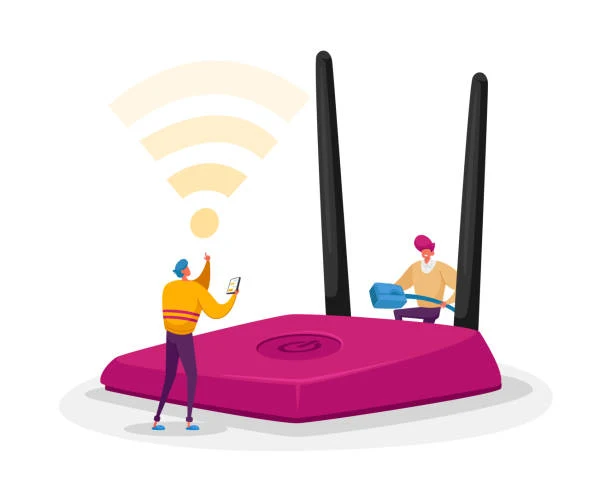In this comprehensive guide, we delve into the fascinating world of wireless networking, exploring the intricacies of Wi-Fi, Bluetooth, and mobile technologies. Our aim is to provide you with a detailed understanding of these technologies, empowering you to make informed decisions and optimize your wireless connections. So let's dive right in!
Wi-Fi: The Backbone of Wireless
Connectivity
Wi-Fi, short for Wireless Fidelity, has
revolutionized the way we connect and communicate. It enables us to wirelessly
access the internet, stream content, transfer files, and more. With Wi-Fi, you
can enjoy high-speed connectivity within the range of a wireless router or
access point.
How Does Wi-Fi Work?
Wi-Fi operates using radio waves to transmit data between devices. It utilizes the 802.11 networking standards developed by the Institute of Electrical and Electronics Engineers (IEEE). These standards define the protocols and specifications that ensure compatibility and efficient communication between Wi-Fi-enabled devices.
Benefits of Wi-Fi:
Wi-Fi offers numerous advantages, making it an
indispensable technology in our modern world. Let's explore some of the key
benefits:
1.
Wireless Convenience: Wi-Fi eliminates the need for physical
cables, allowing you to connect multiple devices simultaneously. This provides
greater flexibility and convenience, enabling seamless integration of
smartphones, tablets, laptops, and other Wi-Fi-enabled devices.
2.
Mobility:
Wi-Fi allows you to access the internet and connect to network resources while
on the move within the coverage area. Whether you're at home, in the office, or
at a public hotspot, Wi-Fi keeps you connected without the limitations of wired
connections.
3.
High Speed:
The latest Wi-Fi standards, such as 802.11ac and 802.11ax (Wi-Fi 6), deliver
impressive data transfer rates. This translates to smooth and fast internet
browsing, lag-free video streaming, online gaming with reduced latency, and
efficient file transfers.
4.
Scalability:
Wi-Fi networks can easily accommodate a growing number of connected devices.
This scalability makes Wi-Fi ideal for homes, offices, schools, and public
spaces, where numerous devices need reliable and simultaneous connectivity.
Bluetooth: Seamless Device Connectivity
Bluetooth technology enables wireless
communication between devices over short distances. It facilitates the seamless
transfer of data, audio, and other types of media, making it an essential
component of modern connectivity.
The Advantages of Bluetooth:
Bluetooth offers several advantages that make
it an integral part of our daily lives:
1. Ease of Use: Bluetooth devices can be quickly paired and
connected, providing a hassle-free experience for users. The pairing process is
typically straightforward and requires minimal setup, allowing you to
effortlessly connect your Bluetooth-enabled devices.
2. Low Power
Consumption:
Bluetooth utilizes energy-efficient protocols, enabling devices to maintain
connectivity for extended periods without draining excessive battery power.
This makes Bluetooth ideal for wireless headphones, smartwatches, and other
portable devices that require long battery life.
3. Versatility: Bluetooth supports a wide range of
applications and devices. From wireless headphones and speakers to keyboards,
mice, and smart home devices, Bluetooth technology offers seamless
compatibility between different brands and models. This versatility enhances
convenience and productivity in various settings.
4. Compatibility: Bluetooth technology is built into a vast
array of devices, ensuring seamless connectivity between different devices and
platforms. Whether you're using a smartphone, tablet, laptop, or other
Bluetooth-enabled devices, you can expect compatibility and smooth
communication.
Mobile Technologies: Empowering Communication on the Go
Mobile technologies have transformed the way
we communicate, enabling us to stay connected wherever we are. Let's explore
two prominent mobile technologies: 3G and 4G/LTE.
3G: The Third Generation of Mobile
Connectivity
3G, short for Third Generation, marked a
significant leap in mobile communication capabilities. It provided faster data
transfer rates, enabling features such as video calling, mobile internet
browsing, and multimedia messaging. With 3G, users could access the internet on
their smartphones with improved speeds and reliability compared to previous
generations.
4G/LTE: The Fourth Generation
Evolution
4G, or Fourth Generation, took mobile connectivity to new heights, offering even faster speeds, enhanced network capacity, and lower latency. The subsequent development of Long-Term Evolution (LTE) further optimized data transmission, ensuring an exceptional user experience for activities like HD video streaming and online gaming. 4G/LTE revolutionized mobile communication, empowering users with reliable and high-speed connectivity on their smartphones and other mobile devices.
Conclusion:
In this extensive exploration of wireless
networking, we've covered the fundamental aspects of Wi-Fi, Bluetooth, and
mobile technologies. Wi-Fi has revolutionized connectivity, providing wireless
convenience, mobility, high speed, and scalability.
Bluetooth offers ease of use, low power
consumption, versatility, and compatibility for seamless device connectivity.
Lastly, 3G and 4G/LTE have transformed mobile communication, enabling features
like video calling, mobile internet browsing, and HD video streaming.
Understanding
these technologies empowers you to optimize your wireless connections, unlock a
world of possibilities, and stay seamlessly connected in our increasingly
digital world.






0 Comments